Lonivie Warner
17 Jun 1873 – 18 May 1948
One
of the unique aspects of life in the Utah Territory among the Mormon
pioneers was the practice the United Order in several communities.
The United Order was a legal entity established to receive property,
convey stewardships back to the donors, and regulate the storehouse
containing surplus commodities and other property. An agent was
appointed to receive property and re-conveyed back to the donor as
much as was sufficient to him, and his family according to their
circumstances, wants, and needs. Each member of the community worked
according to his abilities and skills, giving of his service or
products and in return receiving what he needed. In some communities
it worked better than in others, but eventually it came to an end and
those communities returned to a capitalist economy. This is the story
of a woman, who as a little girl, lived in one of these communities.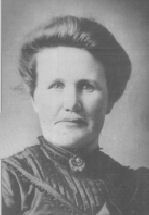
Lonevie Warner, or LaNeva, as she was called, was born June 17, 1873, at Fillmore, Millard County, Utah. The fifth child of Christena Brown and Mortimer Wilson Warner. Both of her parents had come across the plains with their pioneer families, Christena was a young lady who had come directly from Scotland. LaNeva had eleven brothers and sisters.
When she was three years old, they moved to Kingston, Utah where they lived in the United Order for six years before moving to Coyote, Garfield County, Utah (later named Antimony.)
LaNeva started school in Kingston where tuition had to be paid in order to attend. The school, like most others at that time, was a log cabin, and the teachers were employed. The teacher LaNeva had was called Josie by the pupils and was very well liked. LaNeva went to school there for about three years.
In Kingston, the whole community lived as one big family, living a happy contented life. Everyone ate in a large dining hall which was divided so the adults ate in one section and the children in another. However, they lived in their own homes. The men each had certain work to do, the women worked at cooking and taking care of the children.
Baptizing was done only three times in the summer in the Severe River three miles away. LaNeva was baptized by Ephraim Day and confirmed by her father.
The United Order in Kingston lasted from 1877 until 1883, even though the people were happy living it but it was discontinued upon recommendation of the church authorities. At that time the Warners moved to Coyote.
LaNeva learned to be courageous at a very young age as the sight of Indians coming to the door begging for food or other handouts would send any youngster behind their mother's skirts or under a bed. Her father was a good friend of the Indians, and spoke their language. Mountain lions (cougars) were everywhere, after all their habitat had been invaded by these pioneers.
LaNeva
spent her growing up years in Coyote were she met Chancy Frost.
LaNeva and Chancy were married in a double ceremony at the home of
her parents in Coyote, along with LaNeva's brother Wallace Warner and
Chancy's sister Margaret Frost, on September 30, 1890. Chancy was
twenty-four and LaNeva was seventeen. (Later in life she said that
her parents should have spanked her. It is not certain whether she
meant they should have spanked her to prevent it or for doing it.)

Chancy and LaNeva Frost
Chancy's mother, Esther Davis Frost, had bought beautiful glass rolling pins for both couples as wedding gifts, one was blue and the other was clear. Both brides wanted the blue one. So to prevent hurt feelings, Esther wrapped both rolling pins in paper and laid them on the bed letting the brides take their pick. LaNeva got the blue one. (It later ended up in the possession of her great-grand daughter, Sharon Jones of Oakley, Idaho.) LaNeva and Chancy shared a house with Wallace and Margaret for about one year. Her nieces and nephews called her Aunt Lo.
On February 21, 1891 LaNeva had to be re-baptized in order to go to the temple. Her records were lost or unavailable. In order to perform this baptism, the ice in the river had to be broken up.
LaNeva, Chancy, Wallace, Margaret, along with Chancy's brother, Stephen, and his wife Josena, and Mother Frost, all traveled by wagon to Manti, Utah where they were endowed and sealed in the temple on April 1, 1891, five months after their weddings.
LaNeva and Chancy lived on a farm in Coyote where their first seven children Ira. Elva, Nettie, Cora, Nancy Faye, Christine, and Florence were born.
LaNeva had a spiritual experience shortly before the birth of her first child, Ira. She went outside before daylight and heard what she described as a heavenly choir. The sound seemed to come from the east and went overhead and then died away in the west. She went back in the house with tears streaming down her face. Marge Warner was in the house and wanted to know what was the matter. When she could speak, LaNeva told her the story. Years later, when Ira received his patriarchal blessing, he was told that many souls rejoiced when he came to earth.
Ira was born September 11, 1891 in Coyote, Chancy was away herding sheep when he got the news, he hurried home to be with his wife and first son. Chancy announced that his name would be Ira L Frost.
In Coyote, Chancy and LaNeva lived in a log house with two windows and one door. It was a big house for those times, 18 feet by 20 feet. There was one room, and sometimes grain was stored in one end of it. It had a dirt roof, which was typical of log houses. In one corner was a fireplace built of rock. The house had a wooden floor until LaNeva took it out, leaving floor only where the fireplace stood, because there were too many holes in it and pack rats moved right in with them. Also, there were insects to contend with. Finally, LaNeva tore out the fireplace too, because it smoked so badly. After removing the fireplace, they had a wood-burning stove.
Their
home was lighted with a kerosene lamp or candles. Sometimes, they
made what they called a "bitch." LaNeva would braid some
rags together and then lay this material in a bowl with grease or
tallow in it, and then light it.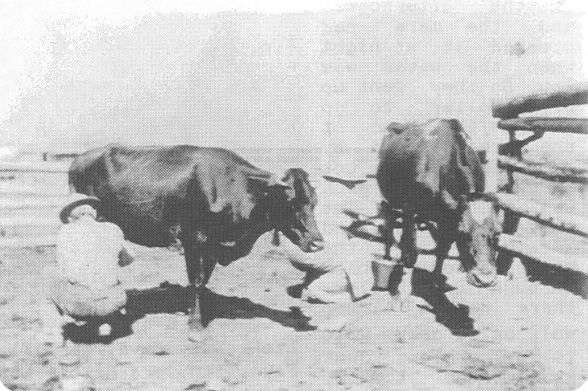
Chancy and LaNeva milking cows
Chancy had to leave the family alone most of the time and this gave much of the responsibility for the children and things around the home and barnyard to LaNeva. LaNeva was a woman of pioneer stock and she knew how to take care of herself and the things around her. She was a good shot with a rifle. Once she got the rifle and shot at a coyote just below the house in the road. LaNeva shot close enough to it to frighten it away, it's heels leaving dust behind.
Once when LaNeva was home alone with the children, she had taken them over to Grandpa Warner's and as they were coming home after dark, they heard something scream. The children wanted to know what was screaming like that. She told them it was the old red cow screaming for her supper. They had to go down across the creek and through a clump of brush to the house. She told the children to hold on to her skirt as tight as they could. Ira and Elva held on to her skirt and she carried Nettie as they ran through the clump of brush up to the house.
After they had got inside the house they heard the mountain lion scream again. He was on the south side of the house. They hadn't much more than got in the house than LaNeva blinded the windows with a quilt. Nettie, the baby, wanted a drink and there wasn't a drop of water in the house. The creek where they got their drinking water was about fifty or seventy-five yards away from the house. LaNeva took the dog and ran as hard as she could go and got a bucket of water and came back. She was to afraid to let Nettie cry for a drink because it would attract the cougar. While she was gone the lion screamed once more and headed for the hills. Looking out your window at night and seeing a mountain lion looking in at you is enough to send chills down the spine of the most courageous.
LaNeva loved to fish and also to eat them. Everybody fished in those days. LaNeva was also a good horseman and rode the range often.
There
were only occasional wolves in the area and once LaNeva and Ira had
an experience with one. When Ira was about 15 or 16 years old, a mare
and her colt got away and went out on the range. They were afraid the
mountain lions would get them. So the next day, LaNeva and Ira went
out on horseback and followed her. They found her across Coyote Creek
but were afraid to cross it, as the water was too high. 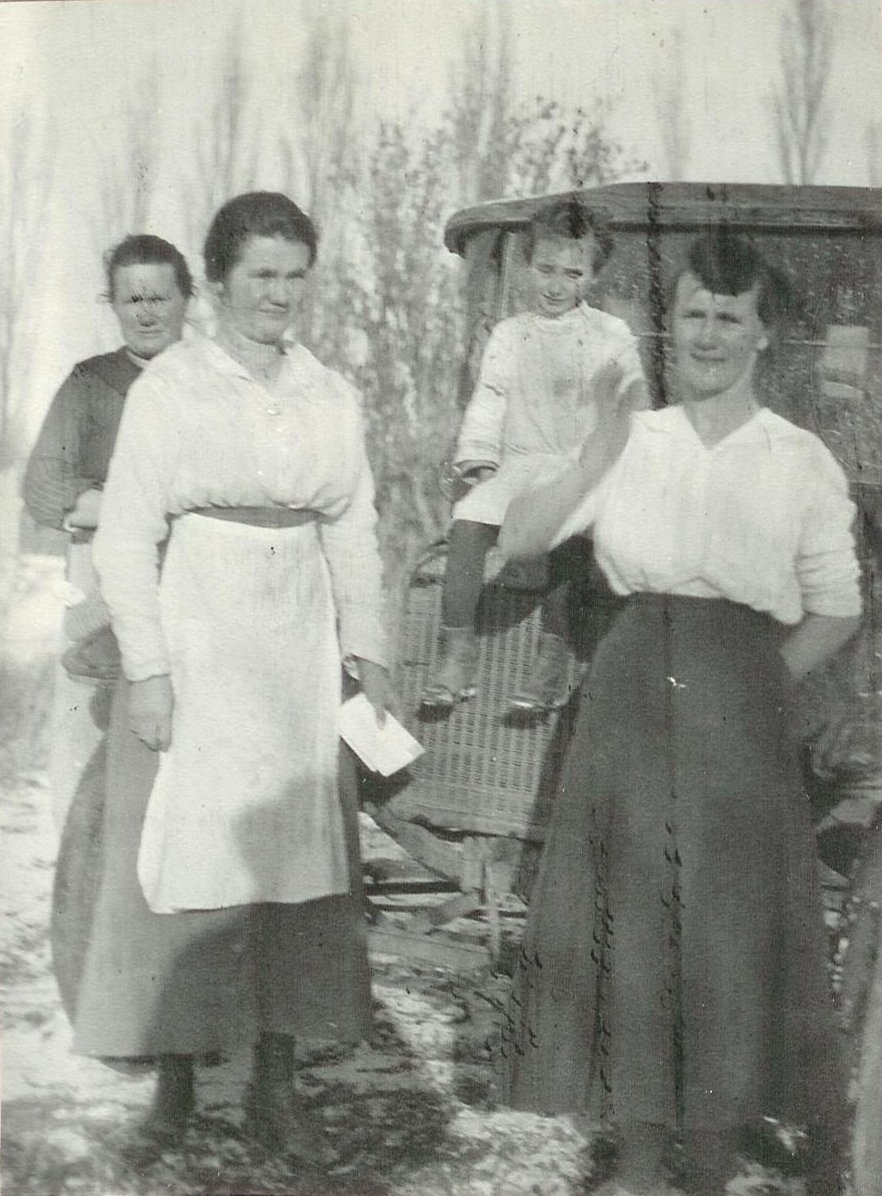
LaNeva, Cora, Ruby, and Elva
The water was higher in the afternoons, and the mare had crossed it at night when the water was low. So they went up Dry Hollow to go around the head of the creek, and by the time they got around it, the sun was going down. The snow was slushy and knee-deep on the horses. Coming back through Dry Hollow, there was a timber wolf or a gray wolf following along just inside the timber, about a quarter of a mile from the road. They couldn't see him, but he was howling all the time.
Ira had a rifle tied on his saddle, so he fired a shot towards the sound of where the wolf was howling. That quieted him for a little while. At the fork in the trail, they took the main road and the wolf took the trail they had been on earlier and then went on the road that led to an old ranch. They went home and the next day got a neighbor to go get the mare and her colt.
In 1908, several families moved to Marion, Cassia County, Idaho. Chancy and LaNeva and family; Wallace and Margaret and family; and Chancy's brother, Stephen and his wife Josena and family. They left Utah and moved to Idaho because it seemed to offer new opportunities. Everyone had "Idaho Fever." LaNeva told her daughters that they would have no one to marry if they had stayed in Utah. Most of the people they knew seemed to be related to them.
Chancy
went to Idaho that spring and stayed until fall. Then he returned for
his family and went back in the fall of 1908. In November they loaded
their household goods in two wagons in Coyote and went to Manti where
they were put on the train. It was at this move that LaNeva decided
that no one would be interested in their old journals, diaries, and
old letters. Instead of packing them, she burned them. What a
terrible loss to their posterity.
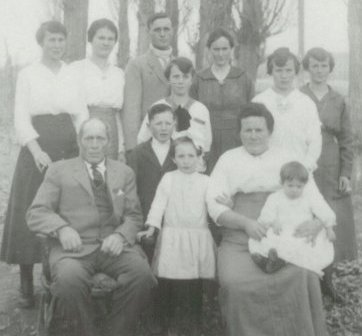
The Frost Family – 1917 Back row: Faye, Cora, Ira,
Nettie, Christena, and Elva. Middle: Florence.
Front row: Chauncy, Earl, Pearl, Lonevie, and Ruby.
Chancy and Ira went to Pocatello with the livestock and furniture. In the meantime, LaNeva and her six daughters rode the train directly to Burley and had rented a house on a ranch in Marion, just north of Oakley. LaNeva's brother, Wallace Warner and his son Deloss arrived in Pocatello with a couple of teams and wagons. And brought their furniture and household items to Oakley. (Wallace and Marge had already moved to Idaho.) Chancy and Ira drove the cattle from Pocatello and arrived in Oakley during the forepart of December.
In Marion, three more children were born to them. They were Earl Warner, Delilah Pearl, and Ruby Geneva. In Marion, LaNeva served as a Relief Society teacher and a teacher of the kindergarten class in Sunday School.
Chancy
and Ira each filed on dryfarm land in Boulder, which was about twelve
miles north east of Oakley. Winters were very severe in the mountains
so a house was rented closer to school. The winter the family lived
there, it snowed for weeks, and being so cold, the snow froze hard
and was higher than the fence posts. The children just walked through
the fields to school, single file, the oldest out in front and the
youngest bringing up the rear. Their scarves tied around their faces
but it did not help much, their breath froze on the scarf. A new
trail had to be made each day because it snowed every night.
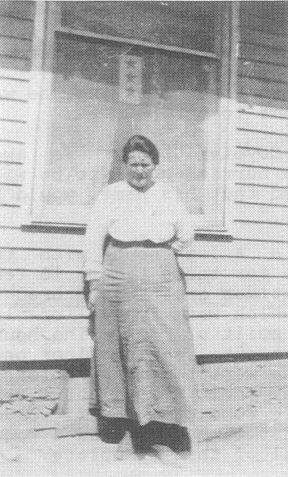
LaNeva
Elva had married Joseph McClaws on December 19, 1914, Nettie had married Stanley Martindale on September 30, 1913, and Cora had married Leonard Drussell on September 19, 1917. In December 1917 Ira enlisted in the Army and went off to fight in World War I.
Early in the summer of 1920, LaNeva went to Burley looking for employment and a house. The remainder of the family moved to Burley into a duplex on Yale Ave. Chancy's sister, Rebecca, and her husband Pete Nielsen and family lived in the other half. Chancy would live at the dryfarm in the summer, leaving LaNeva and the children in Burley. Later they moved to a house on 9th Street.
LaNeva worked at the Burley Laundry along with Faye and Christena, she worked at the laundry for eleven years. (Imagine how hard this must have been without the modern washing and drying equipment and easy-care, no-iron fabrics.) There was a young woman by the name of Vyla Dayley who also worked at the laundry and became good friends with Faye and Christena. LaNeva told them that if Ira and Vyla were to meet, they would get married. That meeting took place over the supper table and a month later, on December 4, 1920, Vyla became a member of the Frost family.

The Chauncy Frost Family -
about 1927 Back row: Christena, Pearl, Elva, Nettie, Lonevie, Faye, Cora,
and Florence. Middle: Ruby.
Front: Earl, Chauncy, and Ira.
LaNeva
and Vyla's mother were both staying with Vyla at the birth of Thelma
on June 23, 1923. LaNeva was surprised one night, as she was sitting
in the rocking chair dozing, to look up and see a women standing
close by . Her immediate reaction was to ask Mother Dayley what she
was doing up, but was startled to realize that it wasn't Mother
Dayley!! The women then disappeared. LaNeva had the good judgment not
to mention this to Ira and Vyla until after they moved.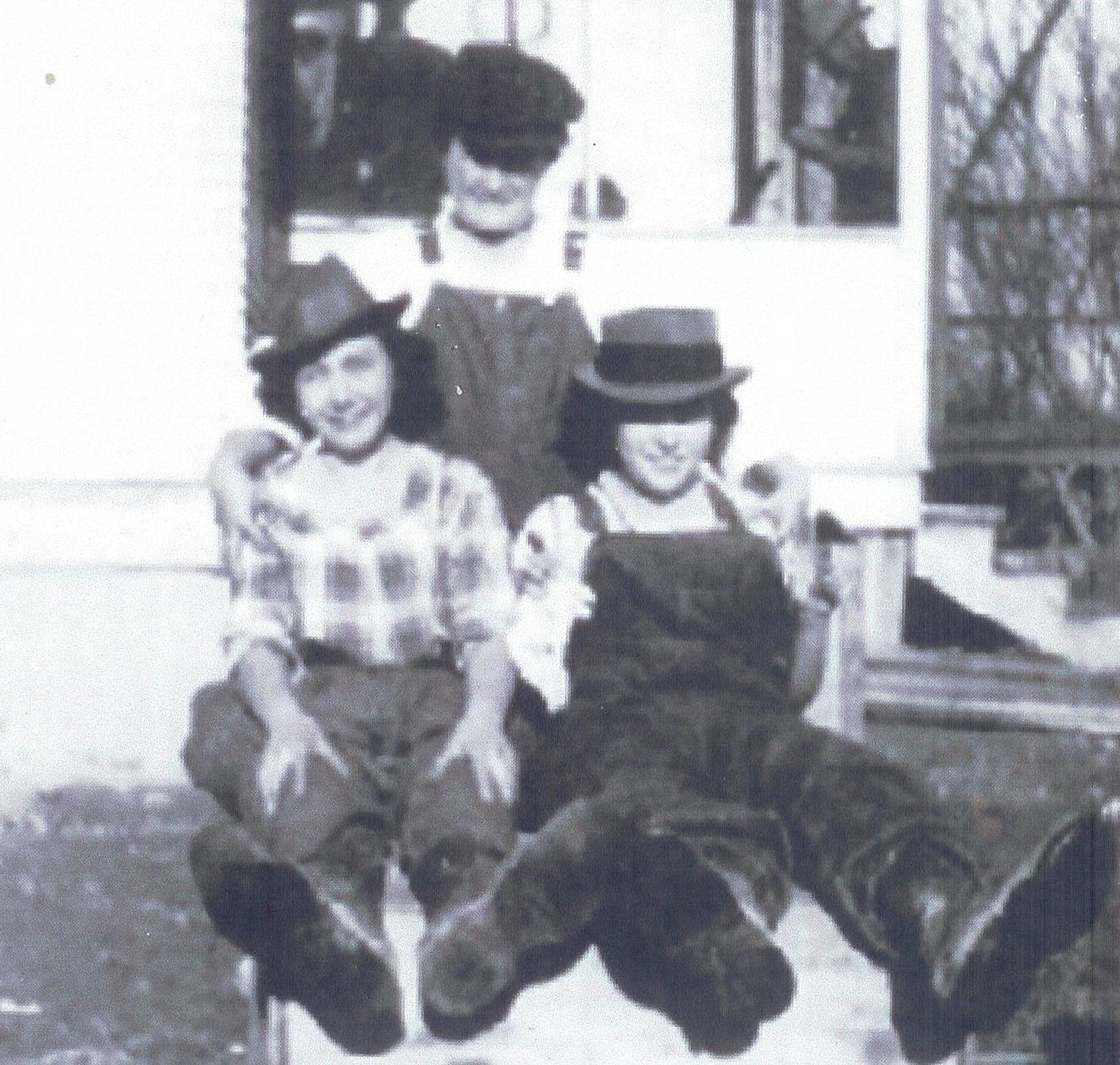
LaNeva, Cora, and Faye clowning around
Florence had married Fred Peterson on September 29, 1923. By that time they bought the house on 9th street.
With the money that LaNeva earned at the laundry, they purchased a home on Schodde Ave. and put two children through high school. The home on Schodde Ave was a four-room house. It was divided into four rooms, with the living room and kitchen on the south side and two bedrooms on the north, with a closet and doorway between them. Doors opened from the living room to one bedroom, and from the kitchen to the other. Outside doors opened into the kitchen on the west and the living room on the east. They had electricity, a single light globe hanging at the end of a wire from the center of the ceiling.
There
was an outside tap close to the kitchen, but they didn't have running
water in the house. There was no bathroom, but there was an outdoor
privy at the back of the lot, aligned with the privies of their
neighbors. There was a porch which faced the street on the east side
of the house that may have been screened. It was a very pleasant
place to sit and visit during the warm summer months. Faye lived next
door to the south, and some of the other married children lived close
by. For many years, there were no houses between the Frost's and
Charles and Carrie Dayley, who lived at the other end of the block.
The family staked a cow and a horse on the vacant lots around them
for a long time.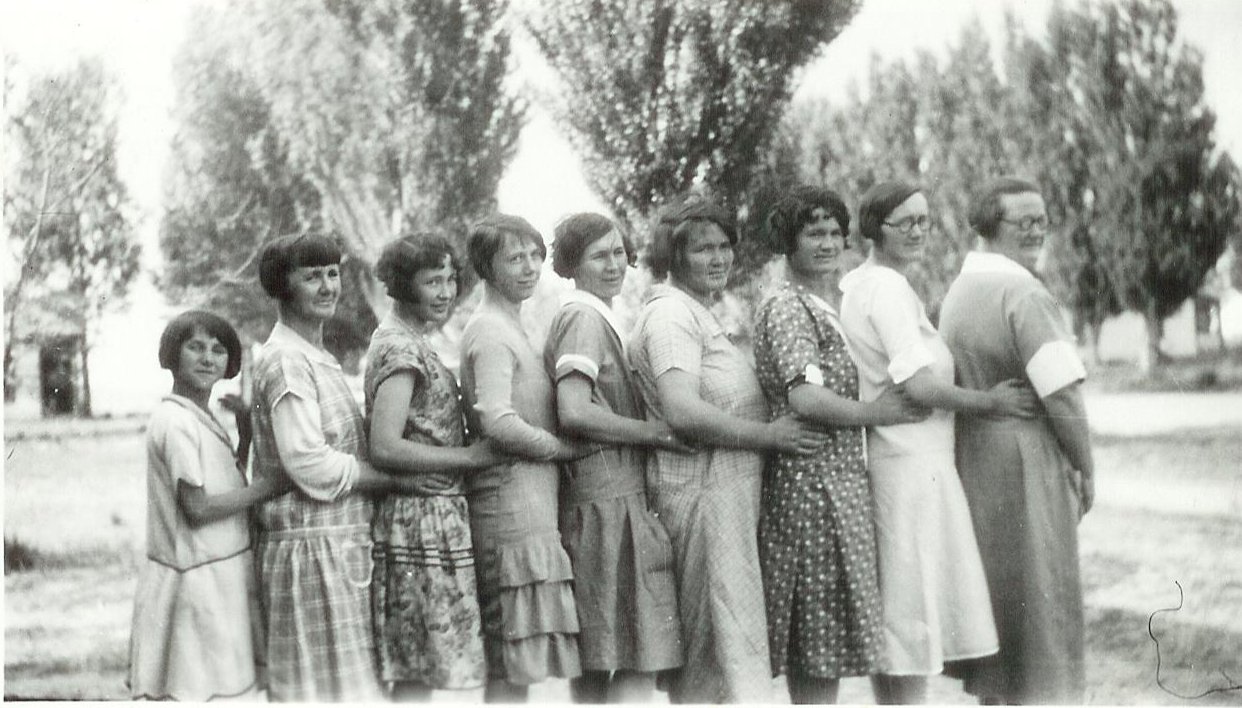
LaNeva and her eight girls. L to R: Ruby, Elva, Peral, Florence,
Faye, Christena, Cora, Nettie, and LaNeva.
The streets in that section of town were not paved, sometimes a water truck came by and sprinkled the streets to settle the dust. Also, the ice-cream truck came along at times. They were in the Burley Third Ward and in about 1921 LaNeva began serving in the Primary, where she worked for many years. She also had been a Relief Society teacher.
In
1929, LaNeva and Chancy adopted an eight-month old baby boy and named
him Samuel Keith. He had blond curly, rather kinky hair. But in 1938,
at the age of ten, he went back to live with his natural father. His
name was changed to Ariel Bowcut, Jr. 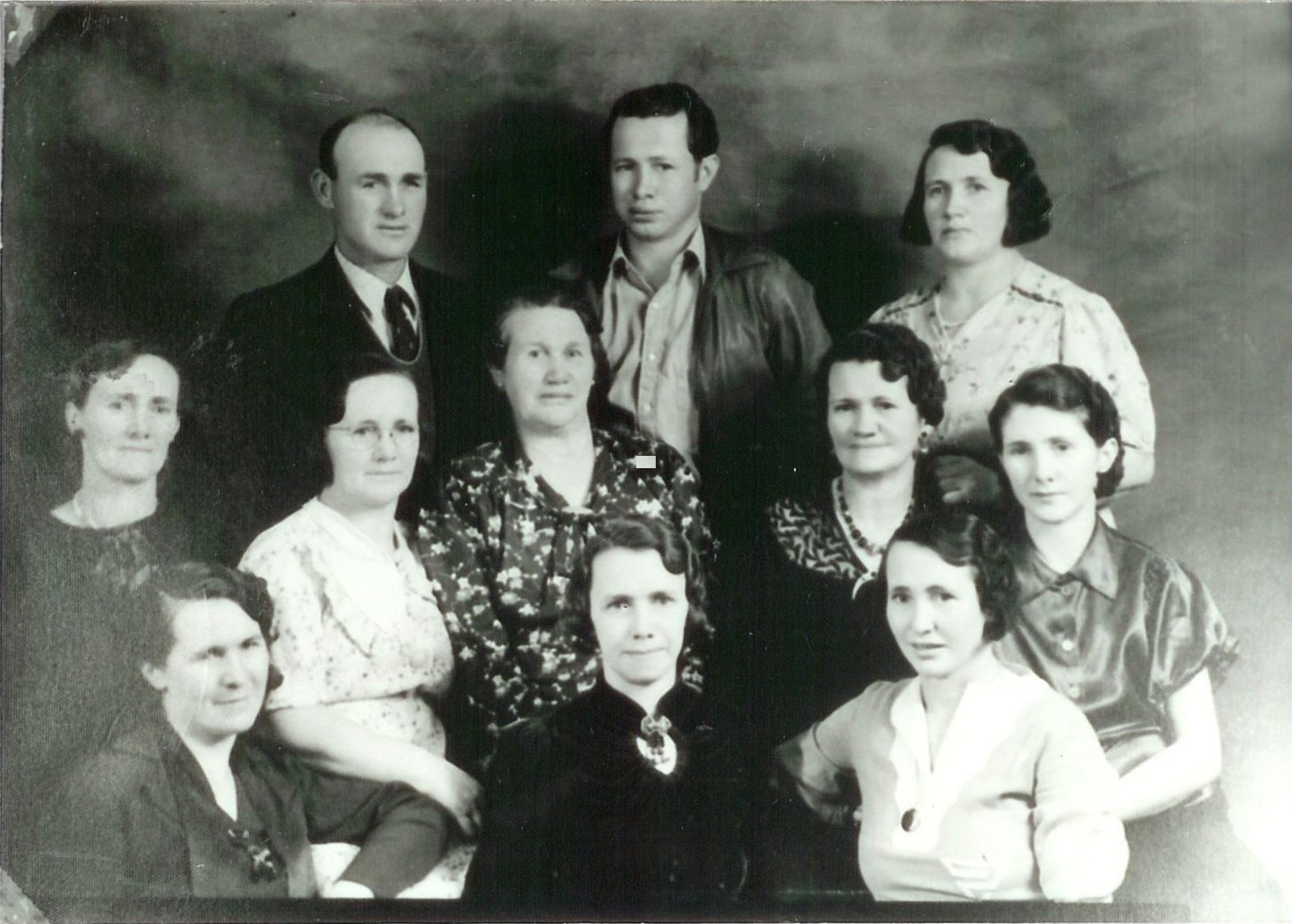
The Chauncey Frost Family in 1935: Back row: Ira, Earl,
Christena. Middle: Nettie, Elva, Lonevie, Cora, Ruby.
Front: Faye, Florence, Pearl.
LaNeva and her eight daughters were all very close and she enjoyed cutting up with them. She was a wonderful storyteller. In her later years her grandchildren enjoyed her stories of life in the United Order and stories of the Indians and cougars that were her neighbors. Besides the cougars there were also coyotes and occasional wolves to contend with. Her stories were many and varied. Her grandchildren had a few favorites that were requested over and over. She knew Orrin Porter Rockwell and told interesting stories about him. She also knew Lyman Wight, another colorful character of the early days of the church.
LaNeva
had dark hair, which stayed dark quite late into her life. She first
wore her hair in a bun at the back of her head, but for the last
several years she wore it short and plain, covering her ears. She was
a "stout" woman.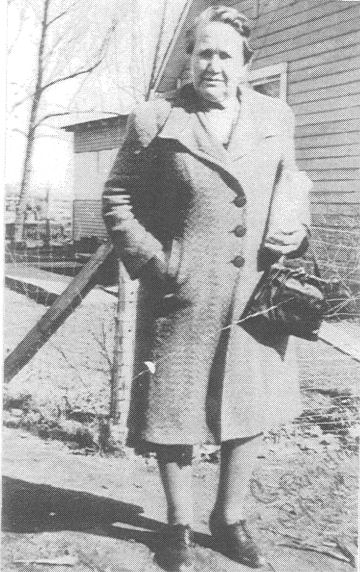
LaNeva in her later years
Her husband Chancy, died May 12, 1930 of pneumonia at the age of 63. As a widow, LaNeva was often seen with her two widowed sister-in-laws, Marge (Margaret Frost) Warner and Becky (Rebecca Frost) Nielsen, who also lived in the Burley Third Ward. Some of the people called them "the three musketeers."
Her daughter Cora was shot and killed by her husband Leonard Drussell on November 10, 1945. LaNeva was never well after that. LaNeva passed away two and a half years later at the age of seventy-five on May 18, 1948 at Burley, Idaho. She is buried next to Chancy in the Heyburn Cemetery.
Compiled from a histories of LaNeva and Chancy by Eunice Frost Read and Celia Frost Gilmour, two of Ira's nine children. "LaNeva" is used in this story because that is what she was called and went by.